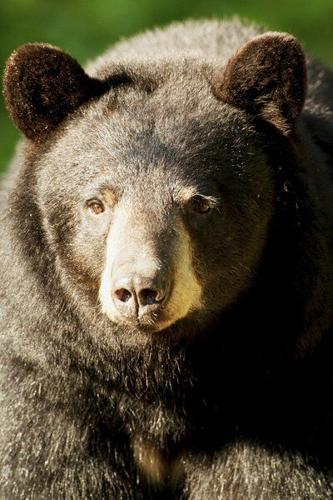Black bear hunting could return to Missouri next year, and the state wants to hear from residents about the possibility.
"Return" may be a bit of a misnomer because there has never been a modern hunting season on black bears in the state. Yet it was unregulated hunting for more than a century along with the destruction of forest habitat that nearly wiped black bears out in Missouri.
"At one point in time, we did think bears were extirpated in the state, essentially driven to zero," said Laura Conlee, furbearer biologist for the Missouri Department of Conservation.
Turns out, though, a few bears — no one knows how many — managed to hang on in isolated and undeveloped corners of Missouri.
Those bears, as well as neighbors who moved up from Arkansas after a restocking effort, have led to the rebuilding of the population, which Conlee estimated is now between 540 and 840 in Missouri.
"At this stage of the game, the population can sustain a harvest," she said, but added that any hunt will be "limited and highly regulated."
MDC seeks public input on the proposed hunting season. If approved by the Missouri Conservation Commission, a season could occur as early as the fall of 2021. MDC is asking for public comment through June 5. Comments can be made online at mdc.mo.gov.
Bears in the Ozarks
No one knows how many bears made their home in the Ozarks before Europeans arrived, Conlee said, but early accounts describe them as common, and scientists believe they were "abundant."
Arkansas had so many it was once known as the "bear state," yet there, too, the population was nearly wiped out. Experts estimated the Arkansas population in 1951 at 40 to 50 bears statewide, most in the lower White River drainage.
Over a 10-year period from 1958 to 1968, the state of Arkansas brought in 254 bears from Minnesota and the Canadian province of Manitoba, rebuilding populations throughout the state.
"It's the most successful reintroduction of a large carnivore in the country," Keith Stephens, spokesperson for the Arkansas Game and Fish Commission, said Monday. Today, Arkansas officials estimate their state has a population of around 5,000 black bears, much of it in the Ozarks and Ouachita highlands.
In 1980, Arkansas allowed hunting for the first time since it had closed it in 1927. Harvest rates are currently averaging between 10% and 15%. Last year, 429 bears were taken; in 2018, 577 bears were killed — the state's highest harvest during the past 40 years.
Stephens said that each spring, young bears set out to find new territory, and over the decades many have wandered into Missouri. That has helped rebuild the state's population.
And it turns out, they were never truly extirpated in Missouri as originally believed, and a few may have hung on in places such as Ozark and Douglas counties. Scientists know that because DNA studies found what Conlee characterized as a "distinct signature," evidence of that original population.
Today, Conlee said, Missouri's bear population is growing at about 9% per year, which means it would double in eight years. Bears also are expanding their range, moving into areas such as Lake of the Ozarks and closer to St. Louis, with Conlee saying they are extremely adaptable and "generalists" that can live off a varied diet. Male black bears in Missouri can weigh several hundred pounds.
"The biggest we have recorded in our research has been over 500 pounds," she said.
She said that black bear hunting will be an important part of managing the growing and expanding population.
Bear management zones
The state is proposing three bear management zones for southern and central Missouri, and each would have its own quota based on the population.
Proposed BMZ 1 would be south of Interstate 44 and Missouri Highway 60, and include McDonald, Barry and Newton counties, as well as counties to the east and along the state line. It is, Conlee said, "high-quality bear habitat where bears have been established for a number of years."
"We certainly get bear reports out of Barry, McDonald and Newton counties," she said, but noted that areas further east, such as Taney, Stone and Ozark, have higher numbers in that management zone.
BMZ 2 would include the southeastern part of the state with large tracts of Mark Twain National Forest. It, too, is considered top habitat with established populations.
BMZ 3 would include an area north of I-44, going as far north as Lake of the Ozarks and Truman Reservoir, where bear numbers are low but increasing, she said.
There are regular sightings of bears in Southwest Missouri, including one last year where a young male most likely driven from the den by its mother wandered through the area for two weeks. It finally ended up in Joplin near Rex Avenue, where it was treed and shot with tranquilizer darts.
Ultimately, state officials determined it had to be euthanized because its behavior had escalated during its time in and around a populated area. It had raided trash cans and beehives and even had torn out a screen to get onto the back porch of a Newton County home.
That decision to euthanize the bear was controversial and prompted criticism of MDC. Conlee expects there will be some in Missouri who might oppose opening a hunting season.
"We're likely to see the full spectrum of opinion," she said. "They are a charismatic species, and they generate a lot of emotions in folks. We encourage folks to submit their comments during this open comment period and we will review all their input."
Other rules?
Conlee said the state is looking at the possibility of a season starting on the third Monday in October of 2021. It would be open for 10 days, or until quotas in each management zone are filled, whichever comes first.
"We don't have quotas established at this point," she said.
About 10% of permits would be set aside for qualified landowners.
The proposal also would limit black bear hunting to Missouri residents. No bear baiting and no dogs would be allowed. Hunters would be allowed to use both archery and firearms equipment, and allowable methods would generally be the same as those for deer and elk.
MDC would offer an annual online permit application period each spring with a fee of $10 per applicant. Permit selection would be determined each summer through a random drawing of all eligible applicants. Those selected would be eligible to buy a permit at a cost of $25.
The agency will take public comments through June 5. Besides online comments, written comments can be mailed to the Missouri Department of Conservation, Attention Michele Baumer, P.O. Box 180, Jefferson City, MO 65102.
MDC said in a statement it will review all public input and finalize recommendations for submission to MDC’s Regulations Committee in July. Those recommendations would then move forward to the commission for consideration in early September.















Commented
Sorry, there are no recent results for popular commented articles.